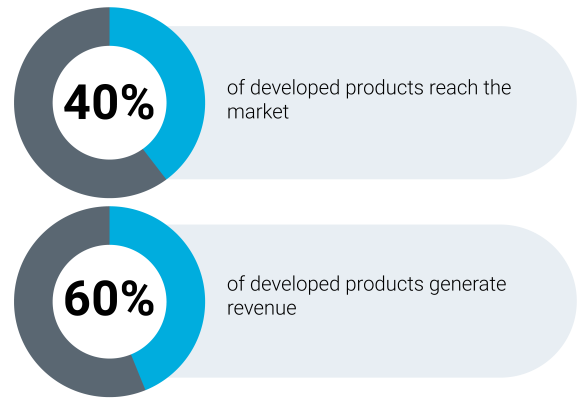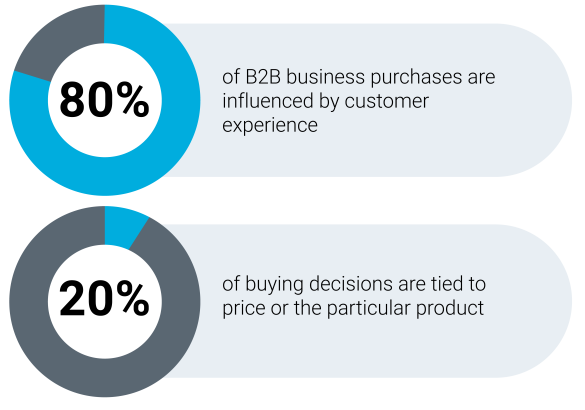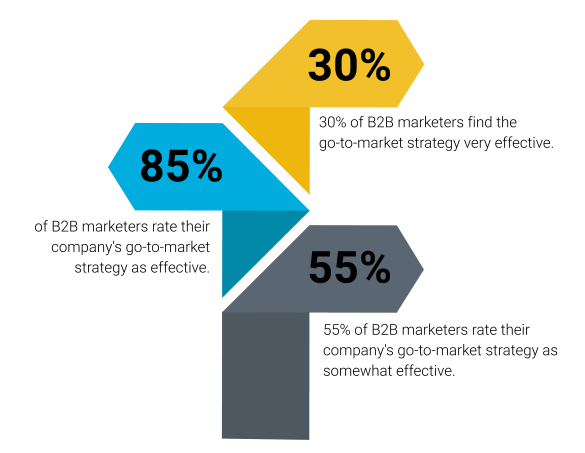A new market is always competitive, with many opportunities to enter and perform, although such market adventures always come with potential risks. Expanding beyond your current market presents challenges, yet a meticulously crafted go-to-market strategy template guarantees success in navigating and flourishing within the new marketplace. Understanding the essentials of a go-to-market strategy empowers businesses to navigate the complexities of introducing a product or service to a new market, fostering brand-to-demand, and ultimately achieving success.
This article presents a comprehensive checklist of essential principles and practices for crafting a data-driven go-to-market strategy, emphasizing the importance of outlining a marketing plan for go-to-market initiatives.
What is a Go-To-Market Strategy?
A go-to-market strategy or GTM strategy is like a roadmap detailing the steps you will take to introduce your product to the right customers and ensure that it delivers its promise of value. It determines who you sell to, how you sell, how to find your target market, and the effectiveness of your sales and marketing teams. A SaaS go-to-market strategy framework aims to build a compelling and successful overall customer experience that will attract, win over, and retain the most desirable customers.
“Your GTM process connects your company strategy to your customer outcomes.”
– Sangram Vajre and Bryan Brown
Understanding the B2B Market
Overview of the B2B market landscape
In the ever-evolving landscape of the B2B market, staying abreast of the latest trends is essential for maintaining competitiveness and aligning with your go-to-market strategy framework. We’re seeing significant shifts occurring in how businesses connect, communicate, and collaborate. The integration of AI and automation stands as a pivotal development, transforming your marketing strategy and processes by granting businesses enhanced capabilities to leverage data through technologies like machine learning and natural language processing. Simultaneously, personalization has become increasingly crucial, enabling B2B businesses to deliver tailored marketing messages that bolster customer engagement and loyalty in line with their go-to-market strategy. Moreover, there’s a growing emphasis on sustainable and ethical marketing practices that influence purchasing decisions and shape brand reputation.
Meanwhile, the momentum behind Account-Based Marketing (ABM) expansion continues to build, offering targeted experiences and improved returns on investment for high-value accounts, reflecting a strategic go-to-market approach. This focus on high-value accounts reflects a strategic planning example where businesses personalize experiences to maximize return on investment. Underpinning these trends is the rise of data-driven decision-making, empowering businesses to craft evidence-based marketing strategies that enhance predictive capabilities and drive superior outcomes in their go-to-market strategy.
However, navigating this dynamic landscape requires focus and efficiency. It’s important to remember that only 40% of products developed ever make it to market, and of those, just 60% generate revenue. This highlights the critical need for B2B businesses to leverage go-to-market strategies to identify the right opportunities, personalize their approach, and maximize the return on their marketing investments.
Understanding the characteristics and journey of B2B customers
Many B2B companies focus on securing business by delivering optimal product packages at competitive prices with timely availability, all as part of their go-to-market strategy. These functional aspects are crucial for competitiveness, making it imperative to thoroughly grasp customer needs to devise effective strategies. Business-to-business (B2B) markets differ from business-to-consumer (B2C) markets, presenting unique characteristics and challenges. In B2B, the target audience comprises companies, which leads to fewer customers but more complex processes. The purchasing decisions involve multiple departments and consideration of product information, technical support, and the preferences of the buying committee. Understanding the dynamics of the buying committee in B2B marketing is crucial for navigating these complex decision-making processes. B2B buyers are rational and demand quality, often seeking to maximize benefits precisely to meet the diverse needs of their organization.
They are well-informed and prioritize engagement and profitability. Unlike B2C, B2B markets involve large quantities, a small number of customers, and need-based segments. Customer communication is critical, with personalized interactions driving satisfaction. Innovation is approached cautiously, grounded in go-to-market research, while packaging takes a back seat to functionality. Additionally, sub-brands are less effective due to the focused target audience. These differences necessitate distinct marketing strategies, segmentation approaches, and communication methods in B2B markets.
Factors influencing purchasing decisions
In the realm of B2B sales, numerous factors sway purchasing decisions, crucial for success amidst advancing technology and product complexities. Trust and reputation stand tall as prime influencers, as companies seek reliable partners with a proven track record and solid market standing. Concurrently, the pursuit of value and return on investment (ROI) remains paramount, with businesses keen on solutions offering tangible benefits and long-term gains. Moreover, social proof and influencer marketing play a pivotal role, with buyers often being swayed by testimonials and recommendations from trusted industry sources. Beyond product features and pricing, organizational goals significantly shape decision-making, aligning solutions with strategic objectives. Corporate culture further impacts choices, with trust, value alignment, decision-making processes, and employee satisfaction all influencing B2B purchasing decisions.
Understanding these psychological factors is pivotal for businesses aiming to drive sales, forge strong relationships, and thrive in the competitive B2B landscape. An effective go-to-market strategy further enhances these efforts, ensuring that offerings are positioned effectively and resonate with target audiences.
Key Components of B2B Go-To-Market (GTM) Strategy
Market segmentation
To effectively position your business, it’s vital to grasp your place in the go-to-market strategy and verify the genuine demand for your product or service. Engage in thorough market research to pinpoint your target audience and ascertain the alignment of your offering with market needs. However, achieving success requires more than just a product-market fit; it necessitates a comprehensive go-to-market plan and a deep understanding of the market landscape. Assess your competitors to discern points of differentiation and similarity. Utilize this insight to carve out a distinctive niche that only your solution can occupy.
Unique value proposition

B2B firms tend to emphasize customer-centricity, value propositions, demonstrations, and capabilities to meet digitized market demands. After pinpointing consumers’ distinctive qualities, the subsequent task is to integrate this unique value into your marketing strategy and offerings, aligning them with your go-to-market strategy framework. What sets you apart from your competitors? What exclusive benefits do you offer that no one else does? Recall the timeless marketing principle: customers don’t purchase a drill for the sake of owning one; they seek a solution to their need for a hole. Emphasize the outcomes your customers can anticipate. How do you address their everyday challenges? Tailor your B2B marketing to focus on these solutions rather than simply showcasing your products or services. According to recent studies, the customer experience influences 80% of B2B business purchases, while only 20% of buying decisions are tied to price or the particular product.
Ideal customer profile
Crafting an ideal customer profile or buyer persona is instrumental in delineating your target demographic. Marketers identify consumers’ tastes, preferences, needs, and expectations based on distinct characteristics. With heightened brand consciousness, consumers extensively evaluate products or services before making choices. Only through a profound understanding of your audience can you effectively guide your messaging in the right direction. Remember, your ICP transcends mere demographics! Incorporate behavioral patterns, firmographic characteristics, and underlying beliefs into your customer portrayal.
Additionally, consider their language usage and cognitive approach to your problem. What terms or expressions will resonate with their challenges? How can you position yourself as their ally in overcoming these obstacles? By comprehending your customer profile, you can fine-tune your B2B marketing endeavors to effectively engage and resonate with them.
Distribution channel strategy
Now that you’ve identified your target audience and defined your message, the next step is to pinpoint where to connect with them by integrating your SaaS go-to-market strategy framework into your channel strategy. Your channel strategy dictates how your go-to-market (GTM) strategy interfaces with your customers. It hinges on your ideal customer profile, messaging, and strategic goals, determining the optimal channels for engagement. Deliberate on both online and offline avenues such as social media, content marketing, direct sales, partnerships, or distribution networks. Tailor your channel strategy to intersect with your audience where they are most active and accessible.
Pricing strategy
B2B marketers must integrate the marketing mix components into a value proposition aligned with customer needs and company objectives, ensuring harmony between price, product, distribution, and communication strategies. Given their insights into the target market and the product’s value proposition, product marketers can offer valuable input on consumer pricing expectations, which is integral to your go-to-market strategy. Your pricing strategy extends beyond mere cost, it entails understanding customer perceptions of value and ensuring they perceive it as a worthwhile investment. In essence, customers want fair value, not overpayment. Striking the right balance between customer alignment and perceived value is key. It’s about demonstrating that your offer exceeds its price tag. Aim for equilibrium that resonates with your audience’s willingness to pay while reflecting your value proposition.
Customer journey mapping
Each customer approaches your brand differently based on their initial encounter. Hence, comprehending and charting the entire customer journey is essential. This enables you to engage each potential customer at their respective stage and seamlessly shepherd them through the remainder of their journey. Understanding the customer journey yields valuable insights into their interaction with your brand. Plotting each customer touchpoint for tech marketers allows the identification of opportunities to elevate their experience, mitigate pain points, and foster stronger connections.
Developing Your B2B Go-To-Market Strategy Template

In today’s competitive business landscape, crafting a successful go-to-market strategy is crucial, and the numbers back it up: a whopping 85% of B2B marketers rate their company’s go-to-market strategy as effective, with 30% finding it very effective and 55% somewhat effective. Here are the phases for developing a successful strategy.
Phase 1: Planning
Define the goal: Before diving into strategies and tactics, it’s essential to establish a clear goal for your GTM strategy. This goal serves as your organization’s guiding light, aligning efforts across teams toward common objectives including acquisition, retention, and monetization, each with specific components such as unit of value, quality, and frequency.
Conduct customer research: Recognizing and comprehending your target customers entails understanding their needs, desires, preferences, and challenges. Gathering both quantitative and qualitative data about your target customers is essential for informed decision-making aligned with your SaaS go-to-market strategy. Quantitative data includes metrics like average contract value (ACV), customer acquisition cost (CAC), and churn rate, providing insights into customer behavior and trends. Qualitative data, obtained through surveys, interviews, and market research, offers a deeper understanding of customer preferences, pain points, and motivations.
Analyze your competition: Understanding the competitive landscape is critical for positioning your product effectively in the market. Analyze competitors’ strengths, weaknesses, product offerings, pricing strategies, and customer feedback to identify opportunities and threats. This analysis helps you differentiate your product and develop a unique value proposition that resonates with your target audience.
Phase 2: Execution
Create positioning and messaging: Your messaging should highlight unique features, benefits, and value propositions, addressing customer pain points and challenges effectively. According to Samantha Middlebrook, VP at Upland Software, their approach to crafting messaging and bringing products to market revolves around understanding the ‘who,’ ‘what,’ ‘why,’ and ‘how,’ allowing them to tailor messaging to meet buyer needs.
Align internal teams: Ensure cohesion and collaboration across departments by clarifying goals, creating marketing implementation plans, and providing regular updates. Clear communication and alignment with key stakeholders ensures that everyone is working towards common objectives, driving the success of your B2B go-to-market strategy for targeted outreach.
Develop your distribution marketing plan: Strategize how to bring your product to market effectively by setting goals, crafting strategies, and determining tactics. Consider factors such as B2B marketing channels, sales channels, distribution networks, and partnership opportunities to reach your target audience efficiently.
Phase 3: Optimization and Scale
Establish feedback loops: Continuously monitor key performance indicators (KPIs), review performance data, and introduce feedback mechanisms for ongoing optimization. Regularly assess the effectiveness of your GTM strategy, identify areas for improvement, and adjust tactics accordingly to maximize impact.
Scale your efforts: Identify successful tactics and strategies and expand them to maximize impact in the market. Scaling involves replicating and amplifying successful initiatives to reach a larger audience and drive business growth. Prioritize efforts that generate positive results and allocate resources accordingly to optimize ROI.

Enhancing your Go-To-Market effectiveness
Launching your offering
An effective launch sets the tone for success and ensures maximum impact in the market. This involves creating a checklist to streamline processes, developing processes for prospecting, optimizing customer pipelines, optimizing resources, and mitigating risks. By aligning your launch marketing plan with your overall GTM strategy, you can capitalize on market opportunities and drive rapid growth.
Sales enablement
Enhancing the efficacy of your GTM approach is mostly dependent on sales enablement. It provides valuable insights into how sales enablement can improve your go-to-market strategy framework. Implementing sales enablement practices ensures that your sales team has the necessary tools, resources, and knowledge to drive revenue and achieve business objectives. By aligning sales enablement initiatives with your go-to-market strategy framework, you can empower your sales force to effectively engage with prospects and close deals.
Monitoring and measurement
By leveraging data-driven insights, you can identify areas for improvement, measure ROI, and make informed decisions to optimize your go-to-market approach. Customer Acquisition Cost (CAC) calculates the expenses of acquiring new customers, informing the efficiency of marketing efforts. Customer Lifetime Value (LTV) estimates the revenue from each customer over time, guiding decisions on customer acquisition costs. Monthly and Annual Recurring Revenue (MRR and ARR) track financial success in subscription-based models. Return on Ad Spend (ROAS) measures the effectiveness of paid advertising campaigns, while churn rate identifies customer retention challenges. Implementing robust monitoring and measurement processes enables you to adapt to market dynamics, refine your strategy, and drive sustainable growth.
Iteration and optimization
Iteration and optimization are ongoing processes that are integral to the success of your B2B go-to-market strategy. By continuously refining your approach based on feedback and insights, you can stay ahead of the competition and maintain relevance in the market. Embrace a culture of experimentation and innovation to test new ideas, iterate on existing strategies, and drive continuous improvement across all aspects of your go-to-market strategy framework.
Go-To-Market Strategy Examples
Slack: Double down on customer experience
Slack has positioned itself as the go-to solution for streamlined team communication. Focused on customer success and referrals, Slack achieved exponential growth and eventual acquisition by Salesforce. By prioritizing customer experience and optimizing the customer journey, Slack solidified its market position and became one of the highest-value startups globally
Socrata: Pivot to meet the market
Socrata recognized the need to pivot its B2B go-to-market strategy when its initial approach didn’t align with market demand. Shifting the focus to governments as a reliable open data platform was a game-changer. Redesigning its product, business model, and marketing efforts, Socrata positioned itself as a trusted partner in the public sector. This strategic shift led to the acquisition of Tyler Technologies, accelerating its vision through data sharing and analytics.
TaxJar: Delves into consistent user experience
TaxJar disrupted the tax management industry by providing engaging, readable content about tax. This approach established trust and authority, leading to increased customer acquisition and retention. By aligning its product with its content strategy, TaxJar ensured a consistent user experience, driving customer success and growth. Its acquisition by Stripe further validates its market impact.

Go-to-Market Challenges and Best Practices
Pitfalls and solutions
Failing to identify your target market can result in missed opportunities and hinder overall product growth. Solutions include building buyer personas by analyzing existing customers, competitor strategies, and customer needs to refine messaging and focus efforts. Remaining in sync with the market is a fundamental challenge in the b2b go-to-market strategy. Determining products, markets, and rivals is the first step in overcoming this. Investigating distribution possibilities also guarantees that various channels may be adjusted to changing market trends. A clear value proposition can help customers understand and strengthen brand positioning. Solutions involve understanding customer pain points, differentiating from competitors, testing different value propositions, and communicating benefits. Prioritizing new sales over customer retention can strain resources and lead to customer dissatisfaction. Investing in support services and customer lifecycle management can build long-lasting relationships, increase retention, and leverage upsell opportunities.
Best practices for successful implementation
Best practices for successful go-to-market strategy template implementation majorly include market alignment, agility & adaptation, and cross-functional collaborations. Firstly, market alignment is crucial, identifying your target market and understanding and prioritizing customer needs over internal goals is essential. Thus, the key steps are conducting primary research with customers, analyzing win/loss ratios, and staying updated on market trends. By aligning strategy with customer needs, B2B marketers can deliver solutions that meet current demand and remain competitive. Secondly, agility and adaptation are vital in the B2B market. Constantly monitoring the key performance indicators and being willing to pivot based on feedback and results are essential. Experimenting with new channels, partnerships, pricing models, and messaging allows businesses to optimize their approach and scale initiatives quickly. This approach, often termed ‘brand-to-demand‘, emphasizes the journey from establishing brand identity to generating customer demand. Lastly, foster cross-functional collaborations among sales and marketing teams, customer success, product development, and more. Sharing KPI dashboards helps keep everyone aligned and working towards the same objectives. Involve all teams in the planning process to ensure alignment of efforts and create a cohesive customer experience.
In conclusion, navigating B2B markets requires a meticulous approach that encompasses market understanding, strategic planning, and effective execution. A well-crafted go-to-market strategy template serves as a guiding roadmap, ensuring success in introducing products to the right customers and delivering on promises of value. By understanding the market landscape, defining target audiences, and articulating unique value propositions, businesses can position themselves for success.
Moreover, prioritizing customer engagement, retention, and satisfaction fosters long-term relationships and drives sustainable growth. While challenges such as market synchronization, unclear value propositions, and sales prioritization persist, implementing best practices such as market alignment, agility, and cross-functional collaboration can mitigate risks and maximize opportunities. Ultimately, by embracing data-driven insights, iterative optimization, and a customer-centric mindset, businesses can navigate B2B markets effectively and achieve lasting success in an ever-evolving business landscape.




